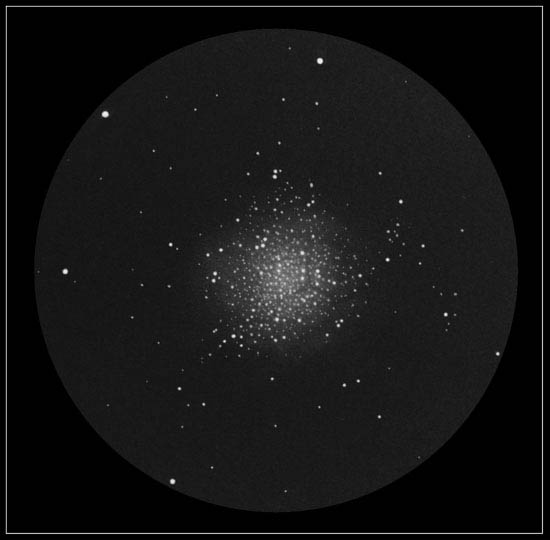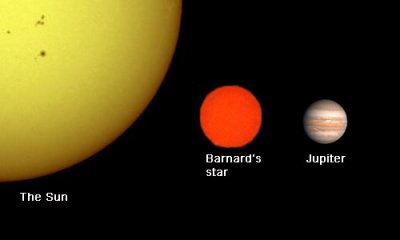-
Posts
53,760 -
Joined
-
Last visited
-
Days Won
455
Content Type
Profiles
Forums
Gallery
Events
Blogs
Posts posted by John
-
-
Great report !
Interesting use of the "vehicle tyre" binary star split measurement tool

It was a lovely night last night and did, eventually, get dark for a little while.
-
 1
1
-
-
OK folks - we have established 2 options on where to source these now and I'm sure there are other vendors as well. They come up quite a lot on the pre-owned market too so there is another option

-
 1
1
-
-
These are Chinese clones of the Japanese Widescan III eyepieces. The earlier Widescan II's were sold back in the 1980's / 90's branded by Fullerscopes as their "Super Wide Plossl" range although it is not a plossl design at all.
I've owned the Japanese versions which, as has been said, were good at F/10 but edge sharpness declined rapidly in faster scopes. I let them go when my main scopes were an F/6.5 refractor and an F/6 dob - the zone of sharpness was just too restricted at those focal ratios. I would expect this clone design to have similar characteristics.
-
After a very nice session of lunar observing, described here:
https://stargazerslounge.com/topic/355693-cracking-seeing-tonight/
I spent some time with my 12 inch dobsonian observing some of the brighter globular clusters and planetary nebulae. Nothing too challenging but nice, relaxing observing.
Messier 13 in particular, was very spectacular with my 6mm Ethos eyepiece - the full sprawling extent of the cluster took up about 1/3rd of the field of view at 265x, The dark feature known as "the propeller" was very evident. Very similar to this drawing by Michael Vlasov:

By the time I was thinking of packing up, Ophiuchus was in full view. Looking at the Sky & Telescope Pocket Sky Atlas reminded me that Barnard's Star, our closest stellar neighbour visible from the northern hemisphere, was well placed, so I decided to have a look at it.
I've not observed Barnard's Star for some time. It is reasonably faint at magnitude 9.5 so a little care is needed to make sure that the correct star is being observed. With my 12 inch dob it was not hard to see tonight and it does have an orange (to my eye) tint to it.
An up-to-date star chart is needed because, due to it's relatively close proximity, Barnard's Star has a large proper motion - just over 10 arc seconds per year.
I found this "Astronomy Now" piece by Ade Ashford very helpful in addition to my Pocket Sky Atlas:
This is the 4th closest star to our solar system and the closest red dwarf apparently. It is only 1.9x larger than Jupiter and a lot smaller than our Sun:

I took the liberty of waving, just in case anyone was observing us from there. Barnard's Star does have at least one known exo-planet which is thought to be about 2x-3x as massive as Earth

Not a particularly hard challenge with a 12 inch scope but a nice way to round off a warm nights observing

It looked nothing at all like this, of course


-
 8
8
-
 2
2
-
-
It was lovely tonight

-
Here is a chart of M57 and the surrounding stars:

The Owl Nebula responds well to a UHC or even better, an O-III filter. They help this object "pop" out of the background sky appreciably.
-
 1
1
-
-
The stock 25mm is not bad but the stock 10mm is a bit poor. The BST Starguiders are a lot better.
-
 1
1
-
-
I have my 12 inch dob out tonight so I might have another shot at SWAN with that if I stay up late.
-
18 minutes ago, Grumpy Martian said:
Hello John. I recently bought a Celestron bracket/holder for my android telephone to use at the eyepiece.Just interested to know what app you use please.
I use a crummy old Samsung S3 mini phone, the standard phone app and the cheapest bracket that I could find. It works OK for my snaps but I don't try anything fancy.
-
5 minutes ago, merlin100 said:
What eyepiece were you using?
For the image a 7.2 - 21.5 zoom but I don't know what setting it was on - maybe around 15mm ?. The mobile camera was "zoomed" a bit as well to frame the eyepiece exit pupil.
Visually I added a 2.25x barlow which takes the top end to 3.2mm so a touch under 500x with this scope.
I have the Nagler 2-4mm zoom in now on the 3mm setting (530x) for stunning views of the Triesnecker Rilles complex

-
My 12 inch scope was cooling while I took part in my society Zoom meeting earlier so once that had finished I could go straight out and observe. The seeing is really steady here currently and the lunar surface a mass of intricate detail
Piling on the magnification, the detail just gets better and stays sharp. Messier and Messier A showing wonderfully at 497x !
Messier is showing it's "tyre tracks" feature across the crater floor. Lovely stuff !
This is an Apollo 15 image of this pair (1 = Messier, 2 = Messier A)
![Figure 115 craters Messier and Messier A]](https://stargazerslounge.com/applications/core/interface/js/spacer.png)
This is my mobile phone snap of a much wider area of the surface:
-
 7
7
-
-
9 minutes ago, Cornelius Varley said:
Unless you are planning to use the telescope for terrestrial viewing as well as astronomy most of us would probably choose a 90degree diagonal instead of the 45 erecting prism diagonal.
Good advice there.
-
I've owned a couple of the 2x 2" Powermates (separate times). I don't image but I found them optically superb for visual observing. Apart from the amplified image, you would just not know they are there.
There are others that get very close and cost less it has to be said. The ES Focal Extender is an example.
But the Powermates are top class IMHO

Used with a big eyepiece you do get a tall stack though

-
 1
1
-
-
Have you thought about the maksutov-cassegrain design ?
Shorter tube so easier to mount steadilly. Long focal length so good sized planetary images. Sharp optics and more aperture for your money than an apo refractor.
-
Virtually all modern eyepieces are sharp in the central 50% of the field of view no matter how "fast" or "slow" the scope is.
It is in the outer 50% of the field that the distortions can start and the extent of those depend on how well corrected the eyepiece is and how "fast" the focal ratio of the scope is. Some of the distortion is generated by the scope optics and some by the eyepiece.
From my experience of using a wide range of different eyepieces in a wide range of scopes I would say that some of the vendors claims are a little optimistic so should be taken as a general guide rather than a precise forecast.
The difference between F/5.9 and F/6 is not significant with this in mind.
-
With scopes, F/5 is considered "faster" than F/6 , F/9, F/15 etc.
-
Skywatcher equipment is manufacturered by Suzhou Synta Optical Technology Co in China and they are part of the larger Taiwanese based Synta group.
As Peter says above, Optical Vision Limited are the official UK importer of this equipment but also import other brands as well. At one point OVL imported the Russian made TAL, Intes and Intes Micro ranges.
-
55 minutes ago, mih said:
Ok, then i want to ask about the Orion Nebula. Is that easier to observe?
Yes but Orion needs to be visible of course !
Messier 42 (the Orion Nebula) is an entirely different type of object from Messier 13 though. Low to medium magnifications are usually used on this target.
Don't give up on bright globular clusters such as M13 though. With a 6 inch scope they are rather nice as you develop your observing skills. I often observe them with smaller scopes than you have and enjoy the views.
The visual views of deep sky objects such as the above won't rival the images that you see of them though, even those made using scopes similar to yours. Modern cameras, long exposure times and processing can produce results that far exceed what our eye can see though a scope.
-
I've just been looking for this one with my 11x70 binoculars. Very low here and hardly any stars showing in that region due to LP. Didn't find it

-
If you use careful focusing, cooled and collimated scope and study for a period of time under a dark sky M13 will show quite a lot of resolution into stars with a 6 inch scope. 100x should be enough but experiment and see what works best for you. 167x might be a bit much unless the seeing and optics are on song but give it a try.
If the seeing is a bit unsteady then the resolution into stars does not jump out at you - you need to carefully observe the cluster to pick it out.
It is not resolved to the core with a 6 inch aperture but the outer parts should certainly be resolved into a speckling of stars against an unresolved backdrop. I first got resolution of this cluster with a 6 inch scope many years ago. The jump from my 60mm refractor was substantial to say the least !
With my 12 inch dob I find 150x - 200x ideal and the view is spectacular but I have 4x as much light and 2x the resolution to play with.
-
 2
2
-
-
When I last owned a TV 32mm plossl, I was advised to get a TV eye guard extender to help position the eye correctly. It worked wonders and made the eyepiece a pleasure to use rather than a bit frustrating as it had been previously.
The downside is that an expensive plossl had become a very expensive plossl

-
4 minutes ago, AdeKing said:
....Just my 2p worth.
Tele Vue do a "2p worth" you know ? - top quality of course and the cost is £1.00

-
 1
1
-
-
44 minutes ago, Jiggy 67 said:
I’d take some of these Bortle ratings with a pinch of salt. Clear Outside says I’m a 6 but another but when I access Clear Outside via Xasteria it says I’m an 8 so I settle on 7 😀
True enough. My sky seems to vary between Bortle 5 or even 4 on a really good night towards the zenith and probably as bad as 8 looking towards Bristol or Newport / Cardiff.
According to Clear Outside I'm a 5.
-
 1
1
-
-
Hi and welcome to the forum

I have not spent much money lately but I have spent a lot of time on the hobby due to the clear skies. It has been a rather unusual but welcome period, at least as far as our hobby does.
Your work in the NHS is very much appreciated by the way

I'm pleased to hear that astronomy is helping you to unwind after what must be very intense periods at work

I hope you enjoy being part of the Stargazers Lounge !
-
 3
3
-












![Figure 115 craters Messier and Messier A]](http://messier.obspm.fr/Pics/Xtra/mc_p121a.jpg)


Summer fun...
in Observing - Reports
Posted
Yes it does, but not much.
An O-III filter is the key to seeing the Veil. It can make the difference between seeing practially nothing at all and a rather nice view. A UHC also helps but the O-III filter is the best on this target.